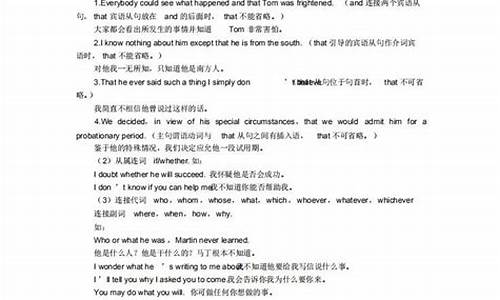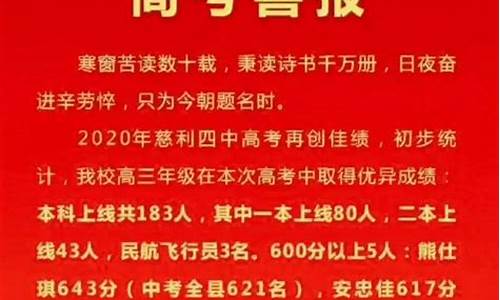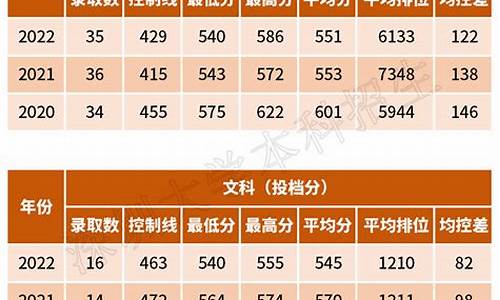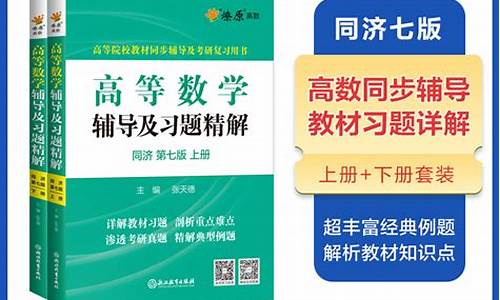广东英语高考定语从句_高考英语定语从句专题

一、已给单词提示题型的技巧
此类题可以考查学生对单词形式变化的掌握程度。单词形式变化主要有两种,一是词的形、数、式的变化,一是词的派生变化。在判断出词的变化之后还应该进一步审题,看是否需要使用复合的变化形式,这一点是很重要的。
技巧一:名词形式变化。名词的形式变化主要有单数、复数、所有格的变化。
例1:There are many students living at school,the(child)houses are all far from schoo1.
由students-词可以判断出横线处应填复数,且作为houses的定语,所以应用其所有格形式,故答案为child的复合变化形式—— 复数的所有格children’s。
技巧二:动词形式变化。动词的形式变化比较多,有谓语的变化(时态、语态、语气),有非谓语的变化(不定式、动名词、现在分词、过去分词)。
例2:A talk——(give)tomorrow is written by Professor Zhang.
句中的is是整句的谓语,所以横线所在的动词应当用作非谓语。从tomorrow可以看出,报告是“将来”作的,故用不定式;且报告是give动作的承受者,故可以判断出横线所在处用give的不定式被动式——tn be given。
技巧三:代词形式变化。代词形式变化通常是与人称变化有关的三大类五小类,即人称代词(主格和宾格)、物主代词(形容词性和名词性)、反身代词。另外还有几个不定代词的形式变化,如no one/none、other/another等。
例3:The king decided to see the painter by——(he).
由介词bv可以看出,横线处应填反身代词himself。
技巧四:形容词、副词比较级变化。英语中大部分形容词和表方式的副词都有原级、比较级和最高级的变化。构成比较级和最高级的方式,或通过加后缀一er和.est,或在词前Imore/less和most/least,且形容词的绝对最高级还要冠以the。
例4:I am— —(tall)than Liu Wen.He is the tallest students in my class.
此题后句交代了LiuWen是班上最高的学生,那“我”肯定比他矮,所以不能用taller,只能用表示程度不如的“less tall”。
技巧五:数词形式变化。数词的形式变化包括基数词、序数词,或加后缀一teen、.ty的变化,甚至还有作分母用的序数词的单复数形式,以及one/two的特殊变化形式。
例5:To my three sons I leave my seventeen horses.My eldest son shall take a half,my second son shall take a(three)...
从上下文连续起来理解,这是一个分马的计划,大儿子分得a half,也就是“一半”或“二分之一”,那么二儿子应该得“三分之一”,所以要填入作分母的序数词“third”才能命中目标。
技巧六:词的派生。词的派生现象在英语单词中是很常见的,派生现象主要发生在名词、动词、形容词、副词四种词中。这种题型还有可能检测学生对词根、前后缀、派生词的掌握。
例6:Lious lost his wallet yesterday,SO he was very____(happiness).
在这道题中,学生很容易判断出该用形容词,由此可知将happinessJ~ .成词根h印py;钱包丢了,人应该是不开心的,所以要再加个前缀Hn.,就成了unhappy。
二、未给单词提示题型的技巧
此类题难度较大,但也是有方法对付的。
技巧七:固定短语结构。根据句中横线前后及整句来判断横线前后是否构成一个固定短语,但有时要对横线前或后的几个单词“视而不见”才能命中答案。
例7:The children were playing on the ground,enjoying____,dirty but happy.
从句中的happy可以 猜出孩子们是开心的,所以应用enj0y oneself短语,故其答案为themselves。
例8:His bosswas____angry astofire him.
如果“跳过”横线后面的angry,就可以发现这里用到一个关联短语SO?as to,所以,so是正解。
技巧八:从句引导词。从句是此题型最为常见的一个方向,主要检测学生对引导词的掌握程度。
例9:He did not done_____his father had asked him to do.
审题可知,横线所在为宾语从句的引导词,此引导词在从旬中充当宾语,且指物,所以是what。
例10:Those_____want to go to the village must sign here.
经过观察可以判断横线所在为定语从句的引导词,进一步观察可知先行词为those,且指人,所以只能填入who。
技巧九:短语动词结构。短语动词是以动词为中心的两个或多个词构成的短语,此类短语中往往是动词与介词或副词连用的多些。
例11:The us consists____fifty states.
根据常识可知,美国由50个州组成,故横线处与前一词组合,表示“由 组成”,所以答案是of。
例12:Mrs Baker was ill,so her daughter had to ask for
leave to take_____of her.
生病需要人照顾,所以答案是care,与前后词构成take care of。
技巧十:短语介词结构。短语介词即多个词的组合起介词作用的短语,如:except for,due to等。
例13:Mr Smithtook a planetoLondon____of taking a train.
此题中说到两种交通工具,所以可以理解此句有“坐……而不是坐……”的意思,故答案为instead,以构成介词短语instead of。
例14:Justthen,he saw a blackboard in_____ofhim.细心观察,可以看出填人fr0nt即可构成in front of,此题得解。
技巧十一:连词、关联短语结构。常用的连词有and,or,but,so,for,while等,常用的关联短语有both……and,either……or,neither……nor,not only……but also等。
例15:Little Wang Jun could not go to school,_____his family was too poor.
此处表示原因,引导的分句其实是一种解释说明,不是必然的因果关系,且前面有逗号隔开,所以填for。
例16:____Marrie and Jannie like going to the theatre.
横线处的词与后面可以构成both?and,故答案为Both。
技巧十二:冠词、介词和常用的副词。冠词只能是在a,an,the之间判断;常用的介词有in,at,on,before,during等,通常考查固定搭配;副词的量还是比较多,如:however,never,yet,much等,但一般不会考查.1y形式的方式副词(见技巧六——形容词派生副词的情况)。
例17:Jackie likes to drive at____ high speed.
这里考查的是不定冠词的习惯用法,答案为a,构成at a high speed,“以高速”开车。
例18:Old Tom’s grand·daughter used to visit him_____Saturday afternoon.
Saturday afternoon是指定的某天下午,所以不用介词in,而用on才是正解。
例19:Though Liu Qiang did the same work____Zhang Wen did,hegotalowerpay______Zhang Wen.
第一条横线可由前面的the same断出用as,第二条横线则可由lower断出比较意义,故答案为than。
例20:It was only one day left,_____,his father had no idea to answer him.
观察上下旬,可以看出是转折关系,且横线与前后用逗号隔开,排除but,所以答案是however。
技巧十三:上下文中出现的相关词。这一招是最为灵活的,但也是最难的。学生可以根据上下文关系和自己积累的知识,填入某个已出现的词,或其反义词,或其同类的某个词。答案的线索可能在本句,可能出现在上下相连的一句,还可能出现在比较远的地方——上下段中与此段位置大体相当的句子。如果该横线出现在某段的首句,则线索可能在上下段的首句;如果横线出现在某段的末句,则线索可能在上下段的末句,以此类推。
例21:Tony____travelling abroad,but dislikes staying home watching TV.
由第二句话中的dislikes可以判断,此横线处应该是填其反义词likes。
定义
I. 定语从句起形容词的作用,在句中修饰一个名词或代词。被修饰的词叫做先行词,引导定语从句的词叫关系词,他的作用一是放在先行词与定语从句中间起了连接作用,二是在从句中担当一个成分,并与先行词保持数的一致。
关系词 先行词 从句
成分 例句 备注
关系代词 who 人 主语 Do you know the man who is talking with your mother? whom, which和that在从句中做宾语时,常可以省略,但介词提前时后面关系代词不能省略,也不可以用that
whom 人 宾语 Mr. Smith is the person with whom I am working
The boy (whom) she loved died in the war..
whose 人,物 定语 I like those books whose topics are about history.
The boy whose father works abroad is my desk mate.
that 人,物 主语
宾语 A plane is a machine that can fly.
She is the pop star (that) I want to see very much.
which 物 主语
宾语 The book (which) I gave you was worth $10.
The picture which was about the accident was terrible.
as 人,物 主语
宾语 He is such a person as is respected by all of us.
This is the same pen as I lost yesterday. as做宾语一般不省略
关系副词 when 时间 时间
状语 I will never forget the day when we met there. 可用on which
where 地点 地点
状语 This is the house where I was born. 可用in which
why 原因 原因
状语 I can’t imagine the reason why he turned down my offer. 可用for which
Ⅱ. as与which的区别:
定语
从句 区别 例句
限制性定语从句 中 名词前有such和the same修饰时,关系代词用as,不能用which He is not such a fool as he looks.
Don’t read such books as you can’t understand.
非限制性定语从句中 as和which都可以指代前面整个主句。如果有“正如,象”的含义,并可以放在主句前,也可以放在后面,那么用as;而which引导的从句只能放主句后,并无“正如”的意思。 They won the game, as we had expected.
They won the game, which we hadn’t expected.
As is well known, he is a famous film star in the 1980s.
Ⅲ. 限制性定语从句与非限制性定语从句的区别:
类别 语法意义及特征 例句
限制性定语从句 对先行词起修饰限制作用,如果去掉,主句意思就不完整明确,这种从句与主句的关系十分密切,写时不用逗号分开。 The accident happened at the time when I left.
非限制性定语从句 对先行词作附加的说明,与主句的关系不十分密切,较松散。从句和主句之间用逗号分开,相当于一个插入语,不能用that引导,关系代词做宾语时也不能省略。 His mother, whom he loved deeply, died ten years ago.
一、考点聚焦
1、功能:相当于形容词,修饰名词或代词,在句中作定语
2、位置:定语从句置于被修饰词之后
Those who are willing to attend the party, sign here please.
3、先行词:被定语从句修饰的词称为先行词
(1)先行词一般是名词和不定代词,如:some-, any-, every-和no与-boy, -thing的合成词;或all、none、any、some、that、those等代词。数词也可以作先行词,人称代词也同样可作先行词。
(2)先行词与关系词是等量关系。必须注意两点:
①先行词在从句中作主语时,从句谓语动词的数由先行词而定。
This is the place which is worth visiting.
②关系词在从句句子中充当了成分,其意思就是先行词的意义,所以在从句中不能重复其意。
There are many places we can visit(them)in China.
4、关系词:引导定语从句的都称关系词
关系代词:who, whom, which, that, whose, as。
关系副词:when, where, why。that偶尔也作关系副词。
5、确定关系词的步骤
(1)先找关系词,看先行词指的是什么。
(2)看关系词在从句中所充当的成分。
6、在定语从句中,当先行词指物时,下列情况的关系词宜用that而不用which
(1)先行词被①形容词最高级 ②序数词 ③数词几种词修饰或被 ④only、any、few、little、no、all、one of等修饰时。
(2)先行词为all、much、little、none、few、one、something、anything等不定代词时。
(3)先行词中既有人又有物时。
He was looking pleasantly at te children and parcels that filled his bus.
(4)先行词在主句中作表语关系词在从句中作表语时。
The village is no longer the one that was 5 years ago.
(5)当主句中含有疑问词which时。
Which are the books that you bought for me ?
7、宜用which而不用that的情况
(1)在非限制性定语从句中
(2)在关系词前有介词时
(3)当先行词本身是that时
(4)当关系词离先行词较远时
8、关系词who与that指人时,也有不同情况分别用不同的关系词
(1)当主句是there be句型时,关系词用who。
(2)先行词是为anyone、those、someone、everyone、one等词时,关系词用who。
(3)当主句是who作疑问词时,关系词用that。
Who is that girl that is standing by the window?
(4)whom在从句中只作宾语,可被who取代。
9、whose作关系词既指人又指物,在从句中作定语。如:
Do you know Mr. Smith whose story is very moving?
There is a room, whose window faces the river.
There is a room, the window of which faces the river.
10、关系代词as,在从句中作主语、宾语和表语。
(1)先行词被such和the same修饰,或句型as many(much)中,从句都用as 引导。
Such books as you bought are useful. The school is just the same as it was 10 years age.
注意:区别①such … that … 引导的结果状语从句。They are such lovely children that we love them much .②the same … that … 引导定语从句。I want to use the same tool that you used just now.
(2)无先行词的定语从句用as和which引导。
区别:①意义上:as 含有“这点正如……一样”。②位置上:as 从句可置句首,也可在另处。
He didn’t pass the exam, as we had expected.
There is lots of air in loose snow, which can keep the cold out.
As is known, the earth is round, not flat.
11、关系副词when与where、why、that
when 指时间 = in / at / on / during which
where指地点 = in / at / from / which
why指原因 = for which
当先行词为way、day、reason、time时,可用that作关系副词。(非正式场合)
I don’t like the way that / in which / he talks.
当time作先行词时,关系词可以省掉。
This is the first time I have given you a lesson in French.
12、必须注意的问题
(1)关系词作主语时,从句中谓语的数。
(2)注意区别定语从句与强调句。
①定语从句中关系词作从句成分,复合句。
②强调it无意义,that / who不是引导词。
③强调it is / was和that / who后如果句子意思讲得通则是强调句,讲不通则不是。
It is the museum that / which we visited last year.(定语从句)
It was in the hotel that we stayed last night.(强调句)
(3)定语从句与同位语从句的区别。
①定语从句引导词被称为关系词,that充当主语、宾语、表语。有时可省略。
②同位语从句引导词被叫做连词,that不能充当任何成分,不可省。
Word came that their army was defeated.(同位语)
We expressed to them our wish that was the same as their.(定语)
(4)关系词在从句中省略的情况。
①关系词作宾语,前无介词时。
②关系词作表语。
(5)限制性定语从句与非限制性定语从句的翻译。
(6)关系词前有介词或复杂介词,关系词只能是which和whom。
(7)几个特殊的定语从句句型:
①He is the only one of the students who has got very good marks in the match.(句中one为先行词)
He is one of the students who have got good marks in the match.(句中students为先行词)
②Is this place the one (that) we visited yesterday? Is this the place (that / which) we visited yesterday?
③He stood at the window, from where he could see what was happening.
④It may rain, in which case the match will be put off.
二、精典名题导解
1. The film brought the hours back to me _________ I was taken good care of in that faraway village.(NMET 2001)
A. until B. that C. when D. where
解析:答案为C。本题考查分隔定语从句的关系词的选择。作好本题的关键是要能辨认出该定语从句的先行词the hours和关系词被介词短语to me所分隔。定语从句的先行词是表时间的名词hours, 并且关系词在从句中用作状语,故应选择表示时间的关系副词when。
2. ___________ is known to everybody, the noon travels around the earth once every month.(NMET 2001)
A. It B. As C. That D. What
解析:答案为B。本题考查as引导的非限制定语从句。as作“正如……”解时,引导的非限制性定语从句来修饰整个句子。当as在从句中作主语时,常用于下列短语:as is known、as is said、as is reported、as is announced等。要注意掌握作关系代词引导定语从句的用法。
3. After living in Pairs for fifty years he returned to the small town ___________ he grew up as a child.(NMET 1996)
A. which B. where C. that D. when
解析:答案为B。本题考查限制性定语从句中关系词的选择。定语从句的先行词是表示地点的名词短语the small town, 且关系词不作定语从句中的主语和宾语而作地点状语,因此定语从句必须用关系副词where引导。要注意分清先行词在从句中充当的成分,然后选择适当的关系词。
声明:本站所有文章资源内容,如无特殊说明或标注,均为采集网络资源。如若本站内容侵犯了原著者的合法权益,可联系本站删除。












